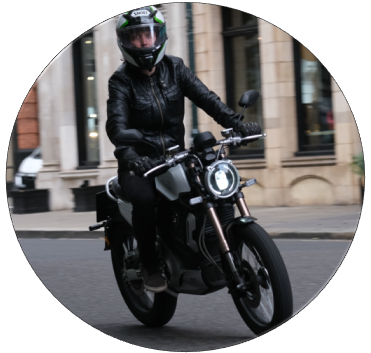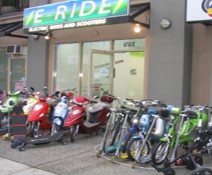


FROM MOTORINO TO JOULE MOTORCYCLES
22 years JOURNY TO SUCCESS
Introduction to Motorino and Joule Motorcycles
- From Concept & Ideation to Business Creation
- In the late 1990s, Steve Miloshev, a mechanical environmental specialist working for a Canadian company, was assigned to operate a pilot plant in China. The project focused on remediating mining drainages contaminated with heavy metals.
- During his time in China, Steve discovered electric bikes and scooters, sparking a deep fascination with their potential. He recognized several compelling advantages:
- Practicality and compact size
- Ease of operation and agility
- Lower carbon footprint
- Potential to alleviate traffic congestion
- Although the early designs were basic, and their quality left room for improvement, Steve envisioned these nimble vehicles as an essential part of a sustainable, urban transportation solution for Canada.
- Upon his return to Canada in 2002, changes to the Canadian Motor Vehicle Safety Act (CMVSA) in British Columbia and Quebec created new opportunities. The revised law excluded electric bicycles—and certain types of electric scooters—from traditional vehicle classifications, provided they met Transport Canada’s regulations. These vehicles were now designated as Power-Assisted Bicycles (PABs), making them accessible without the need for a driver’s license or registration—an appealing option for riders of all kinds.
- Motivated by this regulatory shift and the potential of electric vehicles, Steve founded Greenwit Technologies Inc. in 2002, with the mission to introduce electric bikes and motorcycles to the Canadian market.
Company History & Timeline
2002-2003

A Vision That Sparked a Revolution
In the early 2000s, while working as an environmental specialist in China, Steve Miloshev had a groundbreaking realization: electric bikes and motorcycles represented the future of transportation. These early insights became the foundation of what would soon evolve into Greenwit Technologies Inc.
In 2002, Greenwit Technologies was officially registered as a design, manufacturing, and distribution company for two-wheel electric vehicles. That same year, electric bikes were reclassified under the bicycle category in the Canadian Motor Vehicle Act. This regulatory change meant no driver’s license or registration was required—making these eco-friendly alternatives more accessible than ever.

A Vision That Sparked a Revolution
In the early 2000s, while working as an environmental specialist in China, Steve Miloshev had a groundbreaking realization: electric bikes and motorcycles represented the future of transportation. These early insights became the foundation of what would soon evolve into Greenwit Technologies Inc.
In 2002, Greenwit Technologies was officially registered as a design, manufacturing, and distribution company for two-wheel electric vehicles. That same year, electric bikes were reclassified under the bicycle category in the Canadian Motor Vehicle Act. This regulatory change meant no driver’s license or registration was required—making these eco-friendly alternatives more accessible than ever.

A Pioneering Step into the Future
In the spring of 2003, the first Motorino shop for electric bikes and motorcycles opened in Vancouver, BC. It wasn’t just the first Motorino store—it was the first store in Canada dedicated exclusively to electric bikes, scooters, and motorcycles.
The shop was modest, occupying only 400 square feet, with a single banner on the wall that boldly declared: "THE FUTURE IS ELECTRIC." While many people laughed at the idea at the time, it marked the beginning of a movement toward sustainable urban transportation.

Early Market Challenges
In late 2003, we began attending trade shows to introduce our electric bikes and motorcycles. As early entrants into the market, we quickly realized that most consumers were unsure how to react to the concept. Although we generated plenty of curious feedback, building traction and mindshare proved difficult.
Some scoffed at the idea, saying: “A bicycle with a motor? That’s ridiculous—it defeats the whole purpose of what bicycles are meant for.” Others encouraged us, saying: “You’re in the right place, but it’s too early.” And some joked: “It’s a great idea! When I get older, I’ll come buy one of these.”
Company History Timeline Cont’
2004

Building Relationships and Early Struggles
In 2004, we visited several manufacturers in China to strengthen relationships and expand our product lineup. We placed an order for two containers of electric bikes, hoping to gain momentum in the market.
However, by the end of 2006, we had barely managed to sell the inventory. The challenge? Poor product quality and low public perception of electric bikes at the time.
Early Attempts with Electric Motorcycles
During this time, we also experimented with electric motorcycles. We brought a few models to Canada, but certification challenges prevented us from selling them. Although the bikes had a substantial and attractive design, their overall quality fell short of expectations.
The motorcycles were equipped with heavy lead-acid batteries, making them sluggish and unresponsive. Ultimately, it was an unsuccessful attempt to introduce them to the market.
Adapting Electric Motorcycles to Meet Canadian Standards
The electric motorcycles, while of better quality, still lacked the performance we hoped for. This prompted us to adapt them to meet Canadian safety compliance for electric bikes. We reduced their power output and installed operational pedals to align with regulations.
Initially, the public felt the bikes were too large to be considered e-bikes, raising doubts about their classification. However, after extensive consultations with Transport Canada and multiple inspections by Canadian customs, we successfully proved that they were 100% compliant.
Raising Awareness Through Traditional Advertising
By early 2005, we had improved the quality of our electric bikes, scooters, and motorcycles. However, the lack of public awareness about the practicality of these vehicles continued to hinder our growth.
With internet advertising still in its infancy, we had to rely heavily on traditional advertising methods, including costly TV commercials. At the start of the 2005 season, we ran our first TV commercial for one month on Global TV, marking a significant investment in building awareness.
Company History Timeline Cont’
2005
Financial Struggles and Uncertain Future
By 2005, the company had exhausted its funds, having suffered significant losses due to poor-quality products, low public awareness, and expensive advertising that yielded little to no return on investment.
We approached several bike shops, hoping they would carry our electric bikes—even on consignment—but every one of them refused.
By the end of 2005, we were on the verge of closing and considering bankruptcy as the only option to move forward.


- Early marketing efforts began to pay off as TV stations started interviewing us on various occasions, recognizing us as an innovative environmental business and promoting us across multiple channels.
- Product quality also improved, and we introduced our own best selling Motorino XPh and XPn models. With these upgrades, sales gradually increased, and we began to attract interest from dealerships.
- A composer created a song for the Motorino brand, and a matching music video, titled "LOVE CAN’T WAIT," was produced. The video garnered over 8,000 views on YouTube within the first two weeks.
- On Globe 2006 Our company was the only one presenting electric skateboards, electric bikes and electric motorcycles.
